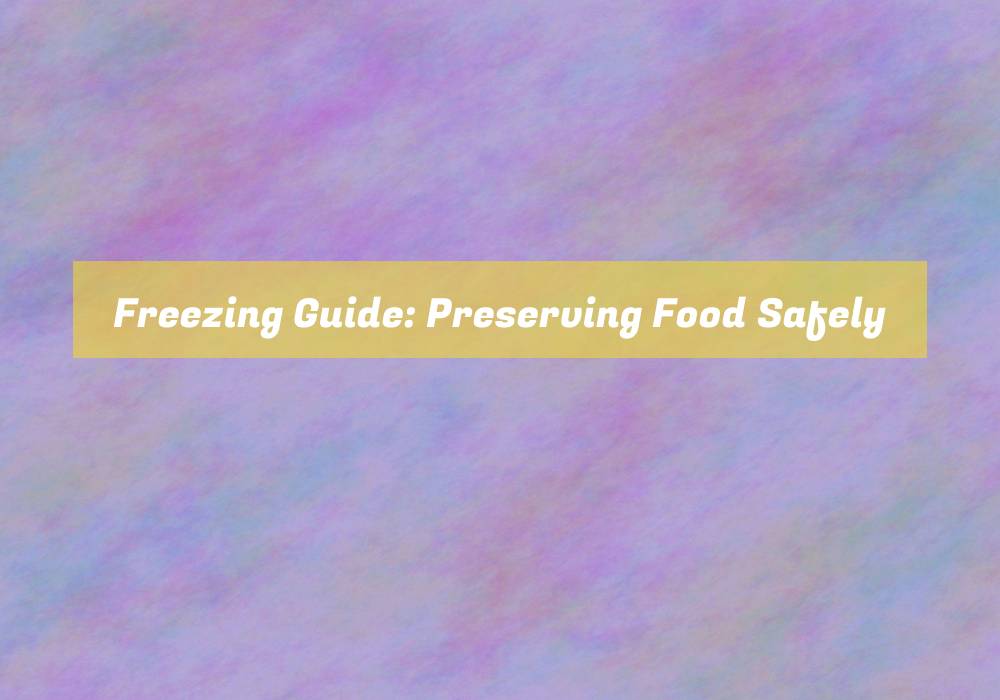Freezing Guide: Preserving Food Safely
You know the saying, G??Waste not, want not.G?? When it comes to preserving food, freezing can be your best friend. But are you doing it safely and effectively?
In this guide, weG??ll explore the ins and outs of freezing food to ensure that your meals stay fresh and delicious for as long as possible. Whether youG??re a meal prep enthusiast or simply looking to minimize food waste, understanding the proper techniques and packaging is crucial.
So, letG??s dive into the world of freezing and discover how you can make the most of this preservation method.
Freezing Basics
To freeze food effectively, ensure that itG??s properly packaged and labeled with the date to maintain its quality. When preparing food for freezing, use airtight containers or freezer bags to prevent air from reaching the food, which can cause freezer burn and deterioration of quality. Make sure to leave some space in the container or bag to allow for food expansion during freezing.
Additionally, label each package with the contents and the date it was frozen to keep track of its freshness. Before freezing, cool cooked foods in the refrigerator to avoid raising the temperature inside the freezer.
When freezing fruits and vegetables, itG??s essential to blanch them first to preserve their flavor, color, and nutrients. For meats, poultry, and fish, itG??s best to wrap them tightly to prevent air exposure.
Choosing the Right Packaging
When choosing the right packaging for freezing food, focus on selecting airtight containers or freezer bags to maintain freshness and prevent freezer burn.
Airtight containers, such as plastic or glass containers with a tight-sealing lid, are ideal for freezing soups, sauces, and other liquid-based foods. Ensure that the containers are specifically labeled as freezer-safe to prevent cracking or breaking in the extreme cold.
Freezer bags, on the other hand, are perfect for storing fruits, vegetables, and meats. Opt for heavy-duty freezer bags that are designed to withstand low temperatures and resist punctures. When using freezer bags, press out as much air as possible before sealing to minimize the risk of freezer burn.
Additionally, consider portioning food items into individual or family-sized servings before freezing to make meal preparation more convenient. Remember to label all packaging with the contents and date of freezing for easy identification later.
Proper Freezing Techniques
For optimal preservation, ensure that the food is thoroughly cooled before placing it in the freezer. This step is crucial to maintain the quality and safety of the food.
Once the food has cooled, itG??s important to package it properly. Use airtight containers or heavy-duty freezer bags to prevent freezer burn and protect the food from absorbing other odors in the freezer. When using freezer bags, squeeze out as much air as possible before sealing to prevent ice crystals from forming. Additionally, be sure to label each package with the contents and date to keep track of whatG??s in the freezer and how long itG??s been there.
When arranging the food in the freezer, leave some space between packages to allow for proper air circulation. This helps the food freeze quickly and evenly.
ItG??s also important to maintain the freezer at the proper temperature, ideally at 0-?F (-18-?C) or lower, to ensure that the food stays frozen and safe to eat.
Thawing Safely
After properly freezing your food to maintain its quality, itG??s essential to thaw it safely to ensure its safety and taste.
The safest way to thaw frozen food is in the refrigerator. Place the frozen item on a plate or in a container to catch any drips and allow it to defrost slowly. This method requires planning ahead as it can take several hours or even overnight for larger items.
If you need to thaw food more quickly, you can use the cold-water method. Submerge the sealed package of food in cold water, changing the water every 30 minutes to ensure it stays cold. This method is faster than refrigerator thawing but requires more attention to ensure the water stays cold and the food stays sealed to prevent contamination.
Microwave thawing is another option for quick thawing, but itG??s important to cook the food immediately after thawing as some areas may begin to cook during the microwave thawing process.
Avoid thawing food at room temperature, as this can allow bacteria to multiply rapidly in the foodG??s outer layers while the inside remains frozen.
Conclusion
Now that you know the basics of freezing food, you can preserve your favorite fruits, vegetables, and meats safely for future use. Remember to choose the right packaging and use proper freezing techniques to maintain the quality of your food.
When itG??s time to thaw, do so safely to avoid any potential foodborne illnesses.
With these tips, you can enjoy your frozen foods without any worries. Happy freezing!






